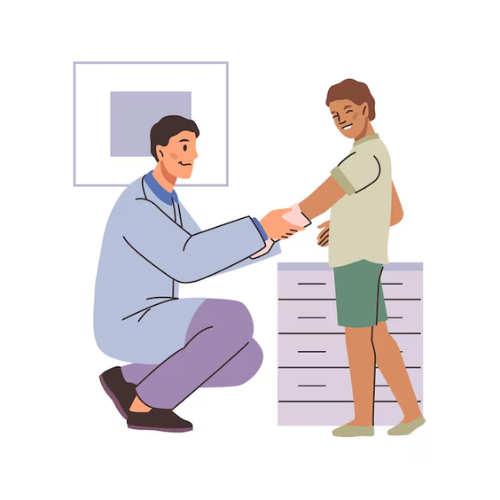The first question that hits your mind when you’re starting to think about testosterone therapy is how long it will take for you to feel the difference the therapy has made. The journey of bringing your testosterone back to normal is a mix of many feelings and also very challenging, especially when you are eager to know if the result is coming soon. In this connection, understanding the testosterone therapy timeline is so critical, as it sets a real premise for your performance & decisions.
On the good side, testosterone therapy makes a person feel like a totally different person as the new mood is in turn reflected in a good mood that comes with high energy, muscle mass, and libido that are extra added results achieved. It is important to mention that those might make the life-changing changes somewhat appear differently and they might vary from individual to individual. In terms of how fast you see improvements, such things must be considered as one’s age, the general state of health, and type of therapy application. So, let’s grasp the essentials of the journey of this metamorphosis.
Learning about Testosterone Therapy
Testosterone therapy implies the substitution of an insufficient hormone through the introduction of the hormone into the body of the patient. The treatment of a deficiency in the individual’s testosterone level, and the elimination of the symptoms that come in the wake of it are the main purposes of the procedure, achieved primarily via different kinds of treatment (e.g., the measurement of hormone status, the explanation of the symptom, etc).
What Is Testosterone Therapy?
Testosterone therapy is a practice in which an individual starts or increases the hormone testosterone after having a low testosterone level. In general, the therapy is considered to be effective in the case of most patients when the symptoms such as increasing fatigue, decreasing libido, and changing in mood are absent during the course of the sessions. A medical practitioner firstly checks the patient’s testosterone levels by taking a blood sample and also makes an inquiry about the symptoms before proceeding to commence the therapy.
The different methodologies include being injected, applying gels, patches, or pellets which are inserted under the skin and they release the hormone slowly, through it the patient can choose which method suits them best, depending on administration frequency, effectiveness, and convenience.
Types of Testosterone Therapy
There are several options for testosterone therapy to meet the needs of each patient:
- Injections: Intramuscular or subcutaneous injections are the most common methods that deliver testosterone directly to the bloodstream. Examples of the most frequently used dosage schemes are those administered once a week or every two weeks.
- Topical Gels: These gels are applied to the skin and are absorbed through the skin, giving a constant release of testosterone during the whole day. Normally, they are applied once a day on clean and dry skin.
- Patches: These are the small pieces that attach to the skin and release testosterone over a longer period. They are usually switched daily.
- Pellets: Small testosterone pellets situated under the skin that ensure a continuous flow of the hormone over time and can last for a few months.
Differentiating the appropriate form for your personal preferences is a subject of your feelings, your doctor’s advice, as well as your medical conditions matched in correspondence.
Factors Influencing Speed of Results
The efficacy of the testosterone therapy is different for the people, depending on various significant factors. By knowing and understanding these variables, you can make a logical choice regarding the speed of the results.
Individual Variability
Regarding the start of the testosterone therapy, individual variability is one of the most important factors in the time it will take to show the results. Factors such as age, body composition, genetic predisposition, and basic hormone values are the ones that determine the speed of the treatment.
Working metabolism and efficient hormone response are the reasons why younger people achieve effects more quickly. Among individuals with the same percentage of fat, those with the most excess body fat may experience the slowest changes since testosterone has a distinct way of interacting with each individual’s fat cells.
Genes can also influence how hormones are assimilated into the body, so for some individuals, the interaction can be different, thereby causing differences in the level of their body’s reactions. The overall state of one’s health, such as an illness that may already be there determines how fast the treatment will work.
For example, endocrine diseases that are persistent will cause the action of the hormones to slow down considerably. Depending on that, a deep understanding of the factors that make up you allows you to form a realistic expectation of the timing and extent of the desired changes.
Dosage and Administration Methods
Dosage and administration are among the factors of the greatest impact on how fast the testosterone treatment acts. A higher number of the first doses is able to set off quick changes in hormone levels, thereby enhancing energetic behavior, mood, and tissues.
On the other hand, lower doses can result in a slower improvement. The method of administration plays an important role in the pace of effects. Injectable testosterone gets quickly absorbed and thus providing very fast results, very often faster ones than from this specific example of drugs (gel, or patch), in contrast to topical gels or patches, may even release hormones more evenly and thus act slower.
Furthermore, each method has a different absorption rate and requires a different period of time to be administered thus it will be reasonable to expect benefits sooner. In conclusion, you can utilize the meeting with your doctor to find the right dosage and way of administration and make your treatment quicker.
Effects Period
At times, the hormone therapy treatment results can be observed within a shorter period; the extent and speed of these changes, however, are not the same for all patients.
What Happens Initially in Terms of Energy and Mood
Within just several weeks, you might feel changes of a dramatic increase in your energy level, an increase in mood. Generally, your motivation will increase, and there will be limits to fatigue. Many patients say about more of feeling good and less flaring up of anger. Certainly, these phenomena are strictly individual and are a direct result of your predisposing hormone levels and health situation. Those who are fitter and fall into a younger age group might expect these initial reactions to be more intensive.
Changes in Physical Condition Over Time
Usually, you will not see physical changes due to the action of the testosterone hormone on the body for the first few months after you have started regular application. It is around 3-6 months post-treatment when you will feel the difference: your muscles will be filled with power and will become larger.
Fat cells will start to shrink notably, and the process can be supported by a regular exercise regime. Your skin tone will get better, and the hair on your head, face, or body will grow differently; in other words, the growing of hair is more common. Quite often males go through the cycle of improved libido beginning at this stage.
Again, the exposition of your skin and hair to sunlight, the therapeutic requirement, and your body’s hormonal balance will together play a specific role in these changes.
Advantages Coming with Long Regular Use
Clearly, testosterone therapy gradually leads to the recovery of warm bone, the promptness of mind, and oversees mood changes as the time of 6 months to a year after the therapy passes by, and even more, effects are likely to continue. Vast improvements in terms of muscle force and endurance can be expected after a year, and the benefits will come to a point that even the patients’ hearts will get better. Of course, a proper periodic adjustment by a qualified healthcare professional is indispensable to get the most out of these benefits.
Considerations and Safety
The utilization of testosterone replacement therapy warrants several considerations and safety precautions. Persons’ knowledge of the potential side effects and the need for regular follow-ups can significantly improve therapy.
Potential Side Effects
Testosterone replacement therapy may cause various side effects. Typically, the side effects are:
- Other side effects of the treatment include acne breakouts and increased hair growth on the face and body.
- Access the profile of your health, if possible, sleep apnea symptoms become worse as a result of therapy.
- During the course of the treatment, people may experience mood swings or increased aggression which are the main signs of deteriorating mental health.
- There are also cases where some users may have gynecomastia which is the unusual growth of the breast in males.
Some of the rare side effects include very high numbers of red blood cells which in turn risk the individual with blood clots and heart problems such as high blood pressure. Furthermore, the timely check-ups performed by your healthcare provider prevent these potential for side effects from occurring and if necessary, adjust the dosage.
Monitoring While Undergoing Therapy
Thorough monitoring plays an indispensable role in checking that testosterone therapy is both safe and beneficial for an individual. The most significant points of observing are the following:
- Regular Blood Tests: This is the usual blood work to test hormone levels, liver functionality, and red cell counts. It is performed 3 to 6 months initially.
- Symptom Tracking: Become aware of the various changes, such as positive ones, including energy levels, and mood improvements, and the negative side effects.
- Health Assessments: Examinations of the heart and prostate conducted regularly will be of great use in assessing your general response to the therapy.
Continuous interaction with the healthcare provider is important in making the therapy effective and at the same time it ensures that necessary alterations are made at the right time, leading to the reduction of hazards and the optimization of the effects.
Conclusion
Knowing the outline of the testosterone therapy journey can help you set your expectations. While some people feel a change in energy and mood within weeks, some others may need several months for a noticeable physical change.
It is important to note that age and body composition factors like these are primarily responsible for the different periods in which results are visualized. Your therapy experience can be improved and your situation can be adequately gauged by events of monitoring and open conversations with the health professional.
With the right approach and waiting, testosterone therapy can be the cure that will bring the biggest benefit and improve the quality of life in general.
Frequent Ask Questions
What is testosterone therapy?
Testosterone therapy is the act of providing testosterone to those who have lower hormone levels. It is done to equalize the hormone levels and, in the process, get rid of symptoms like fatigue, bad mood, lack of interest in sex.
How soon will the effects begin to be noticeable when on testosterone therapy?
Your spirits can be lifted, and you will notice a difference in your energy within 3 to 4 weeks of initiating testosterone therapy. Physical changes, such as muscle mass increase, are mostly visible after 3 to 6 months while the best results may come in half a year to a year.
What methods of testosterone therapy are included as part of the treatment?
The typical forms of treatment are usually carried out using injections, topically in the form of gels or patches, and pellets. Yet, all these ways of delivery have diverse timeframes and levels of effectiveness, and the best decision should be made by the patient in close consultation with the doctor.
What side effects are associated with testosterone therapy?
There is a likelihood of side effects such as acne, hairiness, change in mood, sleep disturbances, and breast growth due to testosterone therapy. Infrequent risks may include the development of too many red blood cells and heart problems.
How do I make sure testosterone treatment is when you get low?
To frequently check the bloodstream through the use of laboratory tests and health checks are extremely important. It enables doctors to make smart decisions and improves patient care through the use of open communication with the healthcare provider.
Can anyone use testosterone treatment?
No, not everyone is suited for going through testosterone therapy which requires a professional in healthcare to assess the potential candidates properly. There are many factors to be considered like individual health conditions and hormone levels.






